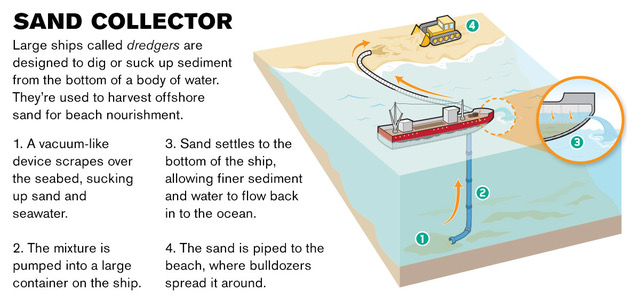Our Changing New Jersey Shorelines: More Than Moving Sand

A variety of processes contribute to the changing appearances of New Jersey’s beaches. Each year, some beaches grow while others shrink as a result of longshore drift gradually pushing sand from one shore point to the next. Nor’easters, hurricanes, and rising sea levels can exacerbate the process, removing massive sections of the beaches along the coast.
What do we do to offset the eroding beaches? Beach replenishment.
Beach replenishment projects pump sand from offshore sandbars onto the beach, where it is packed in to create longer beachers and higher dunes. In recent years, and especially since Hurricane Sandy, replenishment projects have seemed like a constant process on some NJ beaches. In Cape May, replenishment projects began in 1989 and gradually increased in frequency to the point where they occur almost annually. Many of the benefits of the projects are obvious: larger beaches and dunes better protect beachfront communities from storm surges, providing a buffer that can absorb wave energy that would otherwise damage a house or business and they provide the space for families to lay out on the beach without having to worry about rising tides getting towels wet. Regardless of the benefits to us, though, it’s important we consider how the beach replenishment effects the ecosystems at the shore, both the intertidal one that is gaining tons upon tons of sand as well as the offshore ecosystems where the sand is dredged from.
The sand used to widen our NJ beaches is typically mined from about 3 miles offshore, where the composition of the bottom sediment best matches the pre-existing sand. The sediment there is full of infauna and covered in epifauna, which either lose their habitat or cannot survive the dredging process that eventually relocates them to the shoreline. This sediment often provides nutrients for some of the smallest animals in the food chain, which eventually provide energy to the largest animals at the top of the chain. In short, the disruption caused by the mining process can wipe out the communities that live just a few miles offshore. Animals do not immediately return after the dredge has moved on, though. The physical changes to the seafloor may make the area inhabitable for certain species and more hospitable for others, changing the amount of productivity and overall species composition. One study found that pits formed by the mining can take nearly 12 years to refill in some cases and an additional 3 years for species abundance to be restored (asmfc.org). Even though we can’t see the changes beach replenishment causes offshore, it’s important to be aware that protecting our shoreline has effects in more open water that are long-lasting, sometimes even permanent.

What about the ecosystem along the shoreline? One positive of replenishment is that it reestablishes the beach area necessary for animals who lay their eggs in the sand. The option to lay eggs further from the waterline means they are less likely to be washed away prior to hatching. However, the new sand is often more tightly packed than the old and also varies in composition, which makes it harder for some of the burrowing organisms to live along the waterline. The additional sand also changes the energy exerted by breaking waves along the beach, further altering the types of animals that thrive there. This leads to reduced species abundance issues similar to those found at the dredge site. Scientists study different crab and clam species (Mole crab, bean clam, & other various invertebrates) and recognized quantifiable reductions in numbers of some species significant enough to have an effect on shorebirds and fish that prey upon them (Wooldridge, Henter, & Kohn, 2016). As the frequency and intensity of replenishment projects increases, the amount of time needed for the intertidal community to recovery experiences the same increase.
Beach replenishment is full of trade offs. When compared with alternative methods to save our coastlines from erosion, it protects the integrity of the NJ beaches everyone loves so much better than more permanent options, yet it is not the perfect solution. In time, maybe an alternative that does more to protect the ecosystem will arise – but for now, it is something for us to contemplate whenever we see a pipeline on the beach or a dredge offshore.
-Abby O’Neill
Intern at Cape May Whale Watch and Research Center
University of Minnesota-Twin Cities
References
Greene, K. (2002, November). Beach Nourishment: A Review of the Biological and Physical Impacts. Retrieved from http://www.asmfc.org/uploads/file/beachNourishment.pdf
Sand Wars Earth Science Article for Students: Scholastic Science World Magazine. (n.d.). Retrieved from https://scienceworld.scholastic.com/issues/2016-17/050817/sand-wars.html#1050L
Wooldridge, T., Henter, H. J., & Kohn, J. R. (2016). Effects of beach replenishment on intertidal invertebrates: A 15-month, eight beach study. Estuarine, Coastal and Shelf Science, 175, 24-33.
